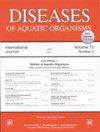Relationship between nutritional condition and causes of death in beluga whales Delphinapterus leucas from the St. Lawrence estuary, Quebec, Canada
IF 1.2
4区 农林科学
Q3 FISHERIES
引用次数: 0
Abstract
ABSTRACT: Carcasses of endangered beluga whales Delphinapterus leucas from the St. Lawrence Estuary, Canada, have been examined consistently since 1983 to determine causes of death. The objective of this study is to compare the nutritional condition of belugas that died of different causes. Previously published categories of death were refined to discriminate acute from chronic pathological processes. Bayesian linear models were used to predict cause of death from the scaled mass index (SMI). Causes of death were as follows: ‘bacterial diseases’, ‘verminous pneumonia’, ‘toxoplasmosis’, ‘other parasitic diseases’, ‘other infectious diseases’, ‘trauma—entrapment’, ‘other noninfectious diseases’, ‘dystocia—postpartum complications’, ‘neonatal mortality’, ‘cancer’, ‘primary starvation’ and ‘undetermined’. The models predicted a lower nutritional condition for the ‘neonatal mortality’ in belugas <290 cm in length and for ‘primary starvation’ and ‘verminous pneumonia’ categories for belugas ≥290 cm. Belugas that died from ‘dystocia—postpartum complications’ or from ‘undetermined causes’ had a higher-than-average SMI. Animals in the ‘trauma—entrapment’ category did not exhibit the highest nutritional condition, which was unexpected since individuals that died from trauma or entrapment are often used as references for optimal nutritional condition in other cetacean populations. Females that died from dystocia and postpartum complications were in similar nutritional condition as females dead from other causes during, or shortly after, pregnancy. This suggests that these females are not obese, ruling out a possible cause of dystocia. Although studying dead animals biases results toward low nutritional condition, our findings support the link between chronic pathological processes and poorer nutritional condition in belugas.加拿大魁北克圣劳伦斯河口白鲸的营养状况与死亡原因之间的关系
摘要:自 1983 年以来,一直对加拿大圣劳伦斯河口的濒危白鲸 Delphinapterus leucas 的尸体进行检查,以确定死亡原因。本研究的目的是比较死于不同原因的白鲸的营养状况。对以前公布的死亡类别进行了改进,以区分急性和慢性病理过程。贝叶斯线性模型用于根据标度质量指数(SMI)预测死因。死亡原因如下细菌性疾病"、"虫媒肺炎"、"弓形虫病"、"其他寄生虫病"、"其他传染病"、"外伤-诱发"、"其他非传染病"、"难产-产后并发症"、"新生儿死亡"、"癌症"、"原发性饥饿 "和 "未确定"。根据模型预测,体长为 290 厘米的白鲸的 "新生儿死亡率 "以及体长≥290 厘米的白鲸的 "原发性饥饿 "和 "害虫性肺炎 "类别的营养状况较低。死于 "分娩-产后并发症 "或 "不明原因 "的白鲸的SMI高于平均水平。外伤-夹伤 "类别中的动物并没有表现出最高的营养状况,这是出乎意料的,因为死于外伤或夹伤的个体通常被用作其他鲸类群最佳营养状况的参照物。死于难产和产后并发症的雌性鲸鱼的营养状况与在怀孕期间或怀孕后不久死于其他原因的雌性鲸鱼相似。这表明这些雌鲸并不肥胖,排除了难产的可能原因。虽然研究死亡动物会使结果偏向于低营养状况,但我们的研究结果支持慢性病理过程与白鲸较差的营养状况之间的联系。
本文章由计算机程序翻译,如有差异,请以英文原文为准。
求助全文
约1分钟内获得全文
求助全文
来源期刊

Diseases of aquatic organisms
农林科学-兽医学
CiteScore
3.10
自引率
0.00%
发文量
53
审稿时长
8-16 weeks
期刊介绍:
DAO publishes Research Articles, Reviews, and Notes, as well as Comments/Reply Comments (for details see DAO 48:161), Theme Sections and Opinion Pieces. For details consult the Guidelines for Authors. Papers may cover all forms of life - animals, plants and microorganisms - in marine, limnetic and brackish habitats. DAO''s scope includes any research focusing on diseases in aquatic organisms, specifically:
-Diseases caused by coexisting organisms, e.g. viruses, bacteria, fungi, protistans, metazoans; characterization of pathogens
-Diseases caused by abiotic factors (critical intensities of environmental properties, including pollution)-
Diseases due to internal circumstances (innate, idiopathic, genetic)-
Diseases due to proliferative disorders (neoplasms)-
Disease diagnosis, treatment and prevention-
Molecular aspects of diseases-
Nutritional disorders-
Stress and physical injuries-
Epidemiology/epizootiology-
Parasitology-
Toxicology-
Diseases of aquatic organisms affecting human health and well-being (with the focus on the aquatic organism)-
Diseases as indicators of humanity''s detrimental impact on nature-
Genomics, proteomics and metabolomics of disease-
Immunology and disease prevention-
Animal welfare-
Zoonosis
 求助内容:
求助内容: 应助结果提醒方式:
应助结果提醒方式:


